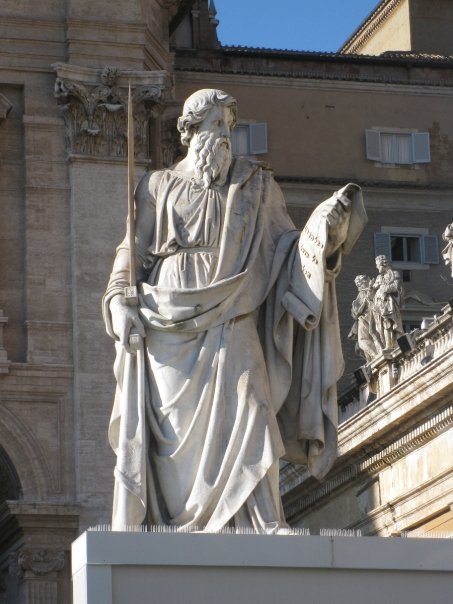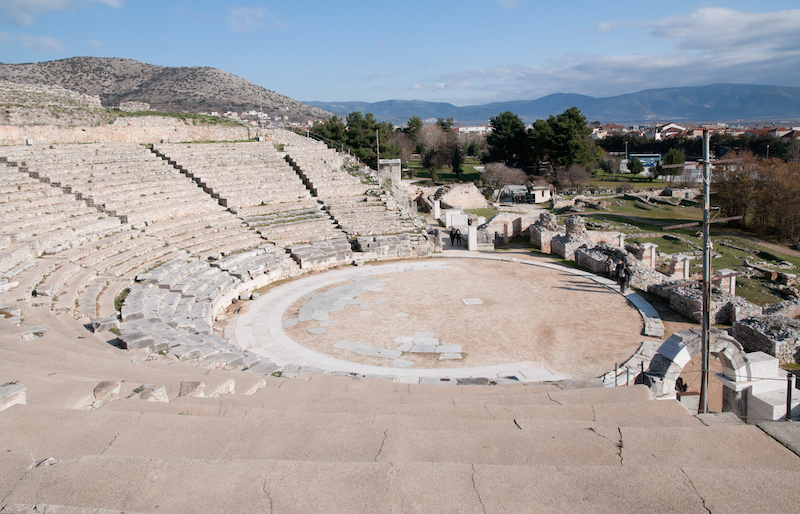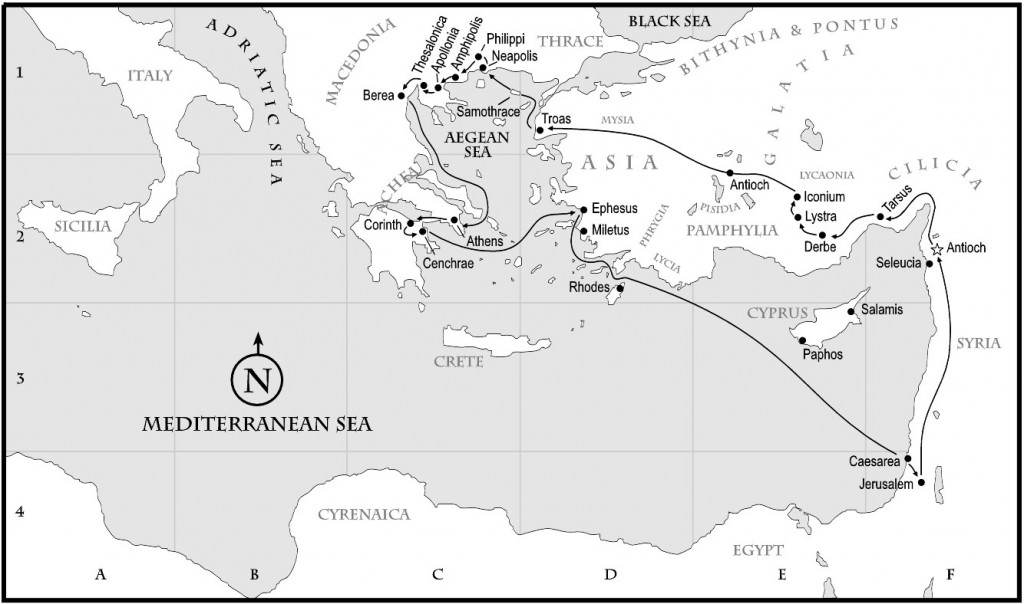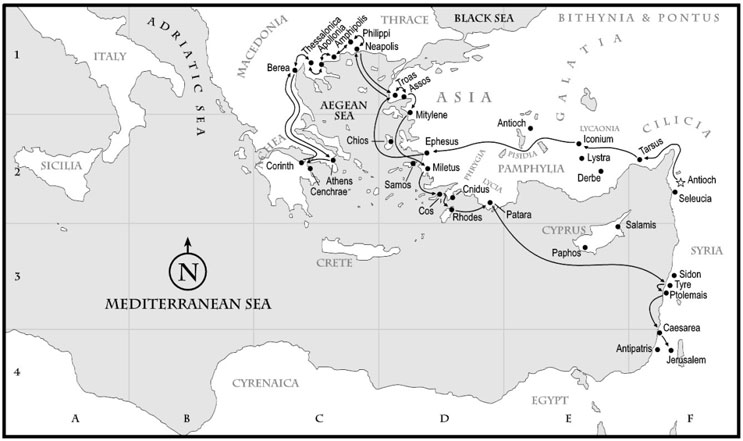Introduction
Before we begin reading any kind of document, it is important to ask some basic questions about that document:
- Who wrote the document? What do we know about that person?
- Where was the document produced?
- When was the it written? What was the situation at the time (political, social etc)?
- For whom did the author write the document? What do we know about the recipient(s)? What kind of document is it? History? Poetry? Sermon?
- Why was it written? What was the purpose of the document?
With these questions in mind, let’s look at the book of the Bible known as “Philippians”. Reading a letter is like listening to one side of a telephone conversation, so we will have to do a little bit of detective work by looking at the text in order to discover the answers… If you would like to watch a short video presentation of this material, please click here.
Who? (The Author)
 The author of the document identifies himself in several places as “Paul”. The Early Church unanimously testifies that this letter was written by St. Paul, the Pharisee who persecuted the Church, who encountered Christ on the road to Damascus and subsequently converted to Christianity.
The author of the document identifies himself in several places as “Paul”. The Early Church unanimously testifies that this letter was written by St. Paul, the Pharisee who persecuted the Church, who encountered Christ on the road to Damascus and subsequently converted to Christianity.
In the opening of this letter he also indicates that “Timothy” is with him, his protege he met on his Second Missionary journey.
Paul’s authorship is further confirmed by the style of writing, as well as in various details found within the document itself. In an age where Biblical scholars question pretty much everything, Paul’s authorship of Philippians remains virtually uncontested.
Although Paul is the author of this letter, it is quite likely that he wasn’t the person writing. It is more likely that he dictated the letter to a scribe.
Where? (The Location)
As noted in the the welcome page, “joy” is the central theme of this letter. We may be surprised to learn, then, that Paul wrote this joyous letter while he was in captivity! However, as we study Paul’s words, we will discover the character of his joy, and begin to see that perhaps this is not as incongruous as we may have first imagined.
Given that we know Paul was in captivity as he wrote this letter, one might think that it would be easy to identify where Paul was when he wrote it. The problem is that, in Acts of the Apostles alone, Paul was imprisoned many times! Our primary choices are:
1. Corinth (c. AD 56-57)
2. Caesarea (c. AD 57-59)
3. Ephesus (c. AD 53-55)
4. Rome (c. AD 60-62)
I would suggest that the last two options are the stronger candidates. The teacher of my New Testament class at the Diocesan Institute favoured Ephesus as the place of writing, but I’d say Rome is the more popular choice among scholars and it is also my opinion, particularly due to the references in the letter to “Caesar’s household” and the “praetorian guard” (headquatered in Rome), references more commonly associated with the “Eternal City”, Rome. Paul ended up in Rome by invoking his right as a Roman citizen to appeal to Caesar.
Multiple Letters?
Some scholars suggest that this letter is actually multiple letters which have been joined together. It is a fairly common conjecture that the central part of the Philippians document (3:2-4:3) represents a letter sent back to Philippi soon after Epaphroditus’ initial rendez-vous with Paul. It is then hypothesized that the remaining parts of the letter which bookend this central portion (1-3:1 and 4:4-4:23, respectively) represent a separate letter, written quite some time later and given to Epaphroditus, to take with him on his return journey home.
Argument For Multiple Letters
In support of this hypothesis, the following evidence is marshaled:
1. External Evidence
In the Second Century, St. Polycarp of Smyrna wrote a letter to the Philippian Church in which he indicated that St. Paul sent them more than letter to that congregation (“…when [Paul] was absent, he wrote letters to you…”)
2. Internal Evidence
There are some awkward joins to be found in the letter, mainly between the first two verses of Chapter 3. The following observations are made:
(a) Unexpected Continuation
In the first verse, Paul appears to be wrapping up his letter (“Finally, my brethren…”), but then continues to write another two chapters, doubling the size of the document!
(b) Unexpected Change of subject
The subject matter shifts unexpectedly between the two verses, with a previously mellow Paul abruptly giving serious warnings about false teachers (“Beware of the dogs!”).
Argument Against Multiple Letters
However, although a good case can be made in favour of the multiple letter hypothesis, it must be noted that it is by no means universally accepted. The abrupt transitions can be explained in a few ways:
(a) Breaking News
It is quite possible that fresh news came to Paul while he was writing, interrupting his previous train of thought.
(b) Nature of the letter
Philippians is not a treatise, it’s a personal letter between friends. When friends speak with one another, they will sometimes make seemingly sudden changes in topic. The subjects might seem unrelated to us, but something in their shared history could very associate those two topics in a way we don’t understand.
Therefore, we shouldn’t jump to conclusions to readily, even if we see abrupt changes of topic in Paul’s letters. There might be a connection between the two subjects which just isn’t immediately obvious to us.
(c) It’s preaching, people!
When I imagine the scene of the document’s authoriship, I imagine Paul passionately speaking, pacing back and forth within a small room, as a scribe scrambles to write down the Apostle’s words.
I once attended a congregation where the pastor would often say something like “So, to wrap things up, I’d like to conclude by saying…”. The only problem is that he’d usually go on speaking for another ten, fifteen, even twenty minutes! Have you ever experienced something like that?
Likewise, have you ever been listening to a homily and noticed that the priest has devoted a good chunk of his time to a topic only tangentially related to the main force of the sermon? I know I have.
If preachers can sometimes unexpectedly continue speaking after they’ve said they’re drawing to a close, and if teachers can spend substantial time talking about something else in the middle of a sermon, is it really that surprising to find Paul doing something similar in one of his letters?
With all that said, there do not appear to by any especially pressing consequences if Philippians is, in fact, a composition of several letters, other than that it would mean that there would be multiple dates of composition and possibly multiple locations of authorship.
When? (The Date)
Those who assert that Philippians was written from Rome, say that it was written during Paul’s two year house arrest in Rome (AD 60-62) which is described at the end of acts, which describes Paul as being under house arrest which would fit well the details of the epistle, with Paul still being about to receive visitors. Paul’s expectation of an imminent trial points to the later period of Paul’s imprisonment (c. AD 62), ten years after the original founding of the Philippian congregation.
It should be noted that Paul was imprisoned in Rome’s Mamertine dungen later in his life, but the academic community generally dismisses this as a possibility for this letter’s composition.
For Whom? (The Recipients)
This letter is addressed to the Philippians, the Christians resident in the city of Philippi, the main city in eastern Macedonia (northern Greece):

The letter is sent to the Philippians through one of the members of the Philippian congregation, a man by the name of “Epaphroditus”.
This document is a letter and it conforms to the format and structure of other ancient letters:
- Author(s) identified
- Recipient(s) identified
- Greeting
- Prayer
- Thanksgiving
- Body of the letter
- Personal greetings
For a more thorough analysis of ancient letter structure, please see my post You’ve got (ancient) mail! This will also be discussed further as we look at Chapter 1.
History & Culture
The city itself was founded by and named after King Philip II of Macedon, the father of Alexander The Great. It was a strategic city, located in the pass of the mountains between Europe and Asia. It was also a rich city, predominantly due to its important location. There were also gold mines outside the city, but these would have been virtually exhausted by the time of the composition of this letter.
By the time of Paul, Philippi was a Roman Colony, having been established as such by Caesar Augustus in the First Century BC. When veteran soldiers completed their military service and granted land and Roman citizenship, they were typically sent out in groups of three hundred, together with their wives and children, to settle in places like Philippi. This conveniently provided the Roman government with faithful citizens at strategic cities around the Empire. The inhabitants took great pride in their Roman identity, with Latin being the official language, even if the everyday tongue was Greek. They followed Roman dress and customs, making colonies like Philippi a “Rome away from Rome” ;-).
Church Founding
The Church in Philippi was founded by Paul himself in AD 50 while on his Second Missionary Journey:

From the account of the founding of the Church in Philippi we know that there were relatively few Hebrews in this city, probably not enough for a synagogue. Some scholars have suggested that this epistle’s lack of Old Testament citations is due to the relatively small number of Jewish members in the Christian congregation.
In the account of the Church’s founding in Acts, three people are identified in the narrative and it is striking how together they cover the gamut of the ancient near east:
1. Lydia
Lydia was asiatic. It is quite possible that “Lydia” might not be a proper name, but may in fact simply mean “The lady from Lydia”. Being a “seller of purple”, a luxury good of the ancient world, it is likely that she was extremely rich and would explain why her house was used by the Church in Philippi.
2. The Jailer
This man would have been a Roman Citizen, and with the job of city jailor would have represented the middle class.
3. The Slave-girl
This girl is a native Greek and, as a slave, represented the lowest level of society, being nothing more than someone’s property.
When Paul preached the Gospel in Philippi, he encountered tremendous persecution. It appears that the Philippian Church likewise experienced persecution after he left. Paul later revisited them at least once while on his Third Missionary Journey about five years later:
Over the course of the letter, we will see that Paul has a real soft spot for the Philippians. They had proven themselves to be faithful and generous. In fact, it was only from the Philippian Church that he had ever received financial support, which they offered on at least two other separate occasions, the twice when he was in Thessalonica and the second when he arrived in Corinth. Because of his warm relationship with the Philippians, we get to see a softer, kinder, gentler side of Paul which we don’t always get to see.
Why? (Purpose)
Paul’s primary purpose in writing this letter was to thank the Philippians for their prayful support and the “gift” they had sent him, most likely money, upon hearing of his incarceration. They sent him this gift to Paul through “Epaphroditus”, the same man who is carrying this letter back to the Church.
As well as thanking them for the gift, Paul uses the opportunity of this letter to:
1. To assure them of his (joyful) prayers for them
2. Give them an update on his (joyful) life
3. Encourage them to (joyfully) endure persecution
4. Exhort them to peace and unity. Two women in particular were threatening the peace.
5. Praise Epaphroditus and reassure the Philippians of his faithful service
5. Warn them against the Judaisiers (legalists) and the Antinomians (libertines)
6. …and to prepare them for Timothy’s arrival
Although this epistle is not really concerned with doctrine, Paul inadvertently provides us with some profound Christological theology.
Assignment
Prior to beginning a study of the letter to the Philippians, read the account in Acts 16 concerning the founding of the Philippian Church.
Questions to ponder
Timothy was with Paul as he wrote this letter. Who are the Paul’s in your life? Who are your mentors in the faith? Who is it that you go to when you have questions or are looking for guidance? Who are the Timothy’s in your life? Who are the people you pour your life into and guide in the faith?
Welcome | Introduction | Chapter 1 | Chapter 2 | Chapter 3 | Chapter 4
